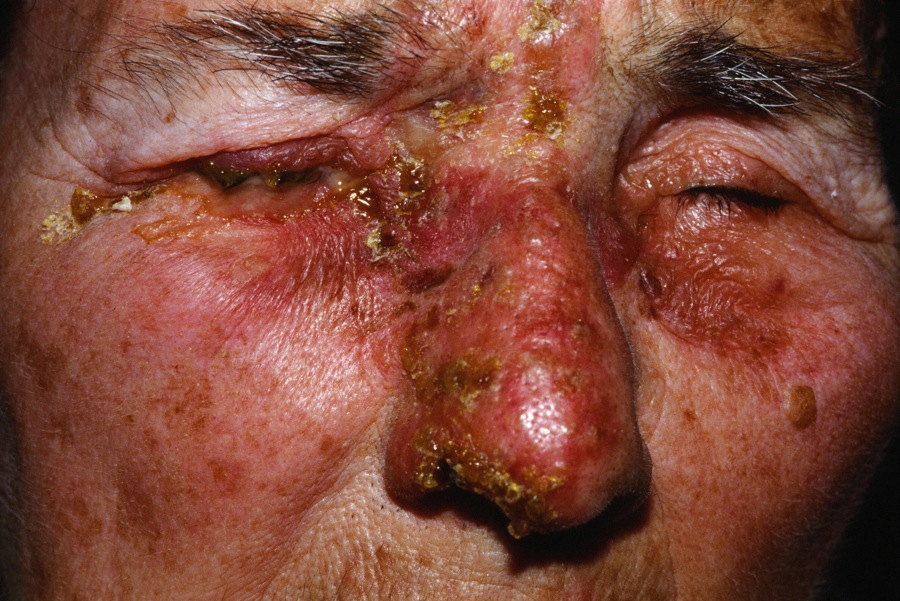
Herpes zoster (HZ) is an acute vesiculobullous eruption caused by reactivation of the varicella zoster virus (VZV). (Zoster means girdle and derives from the dermatomal distribution of the rash.) Varicella zoster virus causes both chickenpox and herpes zoster. After a bout of chickenpox, the VZV remains latent in nerve ganglion cells, typically sensory cells, for years. Reactivation occurs as the immune system surveillance wanes. The sexes are equally affected and the incidence increases with age--most acutely in those older than 60. 50% of unvaccinated people will develop HZ by 85 years of age. Children only rarely develop HZ.
The first evidence of this disease is typically pain felt by the patient. This pain is usually localized to the area that will subsequently develop the rash. Occasionally, the diagnosis can be quite difficult at this stage. If abdominal in location, such things as appendicitis, or gall bladder disease can be difficult to distinguish. One to three days after the onset of pain, the rash appears. The classic appearance of herpes zoster is grouped vesicles on an erythematous base scattered in a dermatome. One of the key diagnostic features is vesicles occurring up to, but not crossing over, the midline. Early on, the vesicles contain clear fluid, but within several days, the fluid becomes pustular and then crusting occurs. In mild cases, there are only individual groupings of vesicles. In severe cases, the entire dermatome is affected with confluent lesions. In some cases, the blisters become hemorrhagic. Ulceration or necrosis may rarely occur. If untreated, the skin lesions resolve in 2-4 weeks with younger patients tending to heal more quickly. Pain felt beyond one month from the onset of the rash is called postherpetic neuralgia (PHN). Various diseases have been noted to occur subsequently in the dermatome affected by herpes zoster.
A few, scattered vesicular lesions may occur outside the dermatome (satellite lesions). If many are present, the term disseminated herpes zoster is used. The presence of satellite lesions convey a higher risk of severe disease. One study found that the presence of satellite lesions conveyed a statistically significant relative risk for severe, multidermatomal and multistage HZ, systemic signs, immunosuppression (e.g., HIV, steroid use) and hospitalization.
HZ rarely presents in multiple dermatomes. When this occurs, a workup for immunodeficiency should be done.
Vesicles on the side of the nose (Hutchinson's sign) indicate involvement of the nasociliary branch of the ophthalmologic nerve. Many ocular complications are possible including conjunctivitis, uveitis, retinal vascular occlusion and ocular muscle palsies. The patient should be referred urgently to an ophthalmologist. See photo below.
Most children with HZ are immunocompromised, have a history of varicella, or were exposed to varicella in utero. However, HZ may occur in normal, healthy children due to either wild-type or vaccine-strain VZV. In a review of 22 cases of pediatric HZ in children who had previously received the VZ vaccine, the average age was 5.3 years. The average time between vaccination and HZ was 3.3 years. Of those tested, half had HZ caused by the vaccine strain and half wild type virus. The latter presumably had subclinical infection by the VZV prior.
This complication occurs in 3% to 5% of patients with herpes zoster with a mean time of onset of skin eruption to pseudohernia is 3.5 weeks. It occurs because the inflammation of the nerve is superimposed on a previous pre-existing condition involving a strain on the innervated abdominal musculature such as distention from constipation or strain from excessive abdominal exercises.

**Herpes Zoster Ophthalmicus. ** The patient should be referred urgently to an ophthalmologist.
Homepage | Who is Dr. White? | Privacy Policy | FAQs | Use of Images | Contact Dr. White